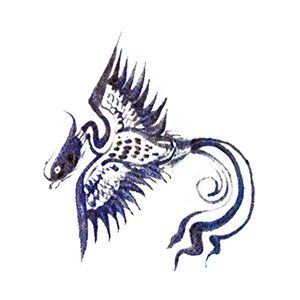Omani Prayer Niches
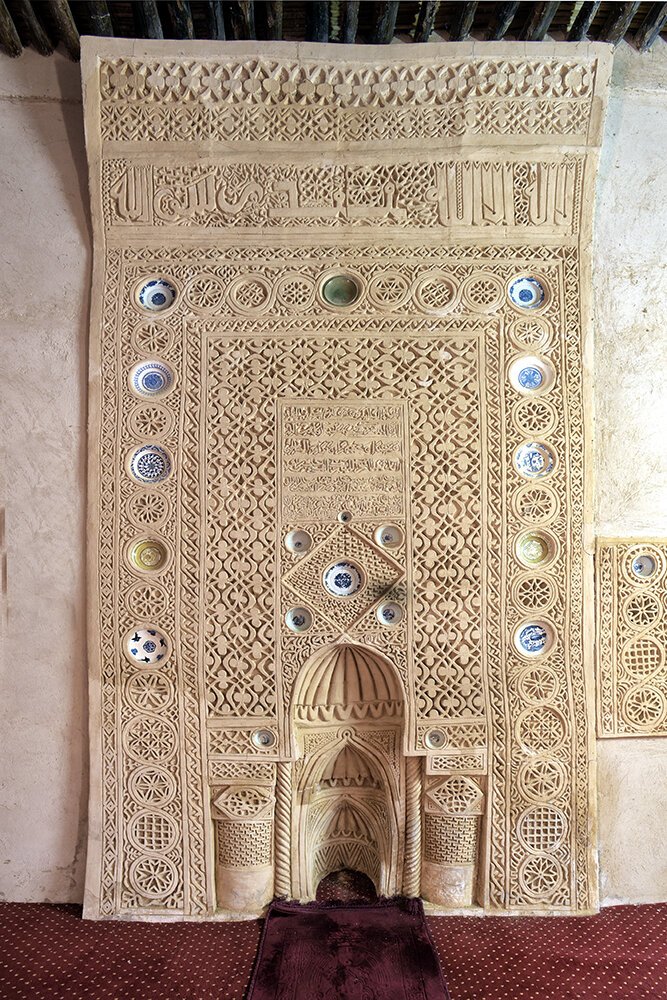
Mihrab of the Great Mosque of Muqazzah, Izki
The mihrab of the Great Mosque of Muqazzah in the Wiliyat of Izki. The mihrab is the work of Ali bin Talib bin Mushmil al-Manhi and is dated 1029 AH, corresponding to 1619 CE.

Prayer Niche of the Great Mosque of Saal Nizwa
The large carved stucco mihrab of the Great Mosque of Saal in Nizwa, Ad-Dakhiliyah Governorate, is the oldest surviving example of the art form in Sultanate of Oman. It is dated Rabi' II 650 AH, corresponding to June-July 1252 CE.
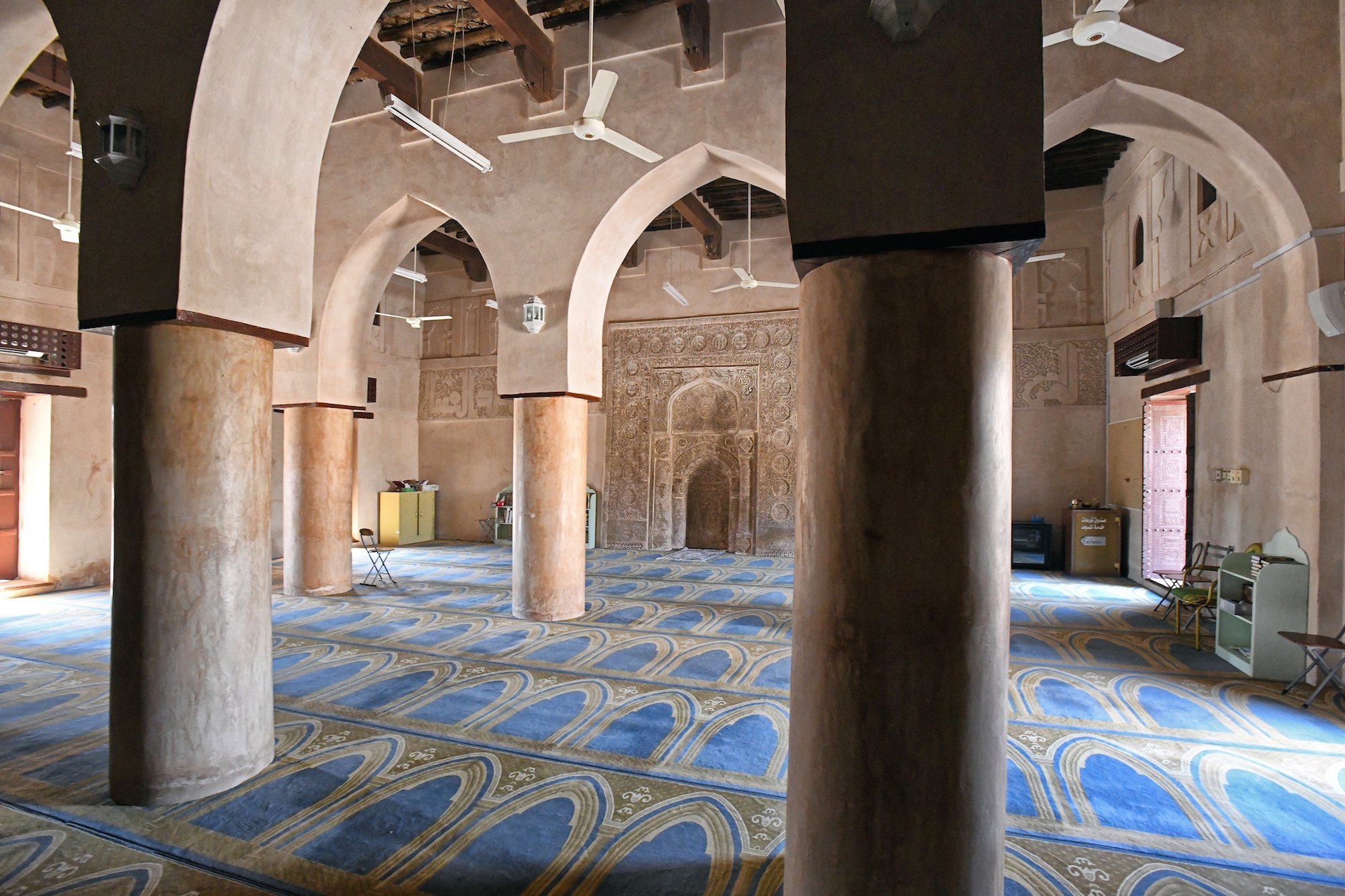
Great Mosque of Saal Nizwa
Interior of the Great Mosque of Saal in Nizwa, Ad-Dakhiliyah Governorate. The carved stucco mihrab is the earliest surviving example of this artform in the Sultanate of Oman. According to an inscription on the mihrab, it was completed in Rabi' II 650 AH, corresponding to June-July 1252 CE.

Al-Masjid al-'Ali mihrab, Harat al-Bilad, Oman
This image shows the mihrab of Al-Masjid al-'Ali in the settlement of Harat Al-Bilad in the Wiliyat of Manah. The inscriptions, central rosette, prayer niche and engaged columns are the work of Abdullah bin Qasim bin Muhammed al-Humaimi and date from 1504 CE. It is the second earliest surviving example of this art form in Oman. The top of the mihrab suggests that it was modified at some point in the past after Al-Humaimi's involvement came to an end, requiring the addition or replacement of the inner band above the columns and the outer band with shallow-moulded tiles. The Ming dish embedded in the central rosette is the earliest surviving example in Oman of the use of inset porcelain as architectural adornment.

Al-Masjid al-'Ali mihrab, Harat al-Bilad, Oman
The upper section of the mihrab of Al-Masjid al-'Ali in Harat al-Bilad, Sultanate of Oman, showing the central rosette and three inscriptions which are the deeply-carved work of Abdullah bin Qasim bin Muhammed al-Humaini. The molded tiles of the band surrounding the central rosette and the outer band with roundels are not al-Humaimi's work.
The top right inscription is the Shahada (First Pillar of the Islamic Faith) and reads:
There is no God but Allah and Mohammed is the Messenger of Allah
The top left inscription reads:
This blessed mihrab was erected by the great sayh the generous and noble one Abdallah bin Wahab may God forgive him and the believers in the Day of Reckoning. This mihrab was completed on Tuesday 13 of the month of Rajab of the year nine after nine hundred from the Hegira [1st January 1504 C.E.] of the Prophet Muhammad, God bless him and grant him salvation.
The second two-line inscription, on a panel above the central rosette, reads:
The work of this mihrab was made by the poor servant, the hoping for forgiveness and mercy of his Lord Abdallah bin Qasim bin Muhammad al Humaymi from Manah who wrote this script by his hand. In the name of Allah, the Beneficent, the Merciful. The date of building of mosque of al-Ali, erected by god for the Muslims was completed in the 8th of the month Jumada II of the year six and seventy after eight hundred [22nd November 1471] from the Hegira of the Messenger, God bless him and grant him salvation. Its promoters were seyh Wahab bin Ahmad and Ahmad bin Sulayman and Hasan bin Sulayman Belqasim and Ahmed bin ... and he was ... of the mosque.

Al-Masjid al-Ali mihrab, Harat al-Bilad
The central rosette of the mihrab, with inset Folk Ming dish. The motif on the dish is of a distressed rock entwined with chrysanthemum blossoms and probably dates from the late 15th century.

Al-Masjid al-Ali mihrab, Harat al-Bilad, Oman
Recessed arches of the prayer niche of the mihrab of Al-Masjid al-'Ali, Harat al-Bilad, Sultanate of Oman.

Al-Masjid al-'Ali Mihrab. Harat al-Bilad
The recessed arches above the prayer niche of the mihrab of Al-Masjid al-'Ali in Harat al-Bilad, Sultanate of Oman, illustrating the loose, free-hand nature of al-Humaimi's early work.

Al-Masjid al-'Ayn, Harat al-Bilad, Oman
The prayer hall (haram) or Al-Masjid al-'Ayn in the settlement of Harat al-Bilad in the Wiliyat of Manah, Sultanate of Oman. The mihrab (prayer niche) is by master craftsman Abdullah bin Qasim bin Muhammad al-Humaimi, a native of Manah, and is the earliest surviving complete example of his work. It is the third earliest surviving example of this artform in Oman and dates from 1505 CE.
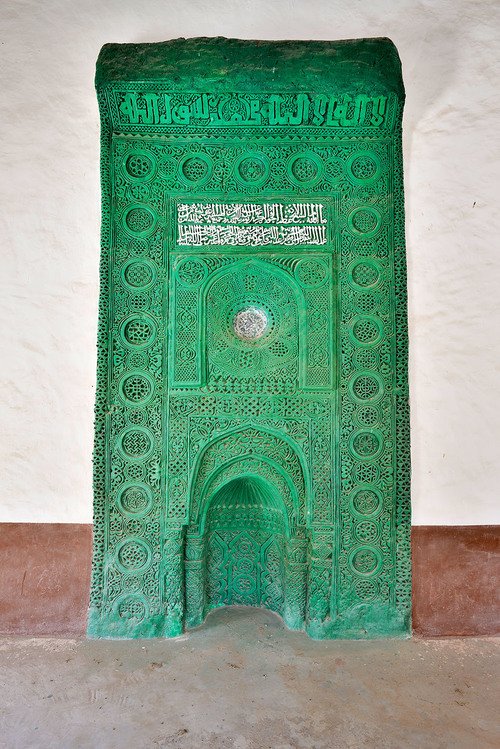
Al-Masjid al-Ayn Mihrab, Harat al-Bilad
The mihrab of Al-Masjid al-'Ayn in Harat al-Bilad, Sultanate of Oman, after restoration and cleaning. The inscription along the top of the mihrab is the Shahada (First Pillar of the Islamic Faith) and reads:
There is no God but Allah and Mohammed is the Prophet of Allah
The two-line inscription above the central rosette reads:
Promoted by the great Sheikh, the generous and noble one, may God forgive him in the Day of Judgment from his sins with all the Muslims, I mean Abdallah bin Wahab bin Ahmad
Work of the poor servant of God, the hoping for mercy and forgiveness of his Lord. Abdallah bin Qasim bin Muhammad al-Humaymi, from the village of Manah, and it was completed in the month of Muharram in the year nine hundred and eleven years [Jun-Jul. 1505] from the Hegira.

Al-Masjid al-'Ayn mihrab detail
Detail of the mihrab of al-Masjid al-‘Ayn in Harat al-Bilad, Sultanate of Oman, showing the outer bands of alternating larger and smaller medallions set within a stylized floral surround, redolent of the gardens of paradise, and entwined in a so-called ‘endless knot’, which may symbolize the endless space and time of Creation.

Al-Masjid al-'Ayn Mihrab Detail, Oman
The prayer niche of Al-Masjid al-'Ayn in Harat al-Bilad, Sultanate of Oman, with recessed arches and engaged columns. photographed at sunrise.

Folk Ming dish, Al-Masjid al-'Ayn Mihrab, Oman
The Folk Kiln blue and white Ming dish embedded in the centre of the rosette of the carved stucco mihrab of al-Masjid al-‘Ayn, Sultanate of Oman, showing a phoenix in flight among lotus blossoms. The calligraphic style of the painting and the year of construction of the mihrab (1505 CE) would suggest that the dish was manufactured in the late 15th century, during the latter part of the Chenghua and Hangzhi Period (1465–1505 CE).

Ming Dish, Oman
A late 15th century Ming porcelain dish in the central rosette of a carved mihrab (prayer niche) in Al-Masjid al-'Ayn in the ancient fortified settlement of Harat al-Bilad, Manah, Sultanate of Oman.

Great Mosque of Bahla mihrab, Oman
The mihrab of the Great Mosque of Bahla, Sultanate of Oman, dated 917 AH/1511 CE, is partly the work of Abdullah bin Qasim bin Muhammad al-Humaimi, who is credited with reviving the art of mihrab carving in first two decades of the 16th century. Only the central section and upper inscription band and crown of this mihrab are attributed to him, the rest being fabricated of molded tiles. Whether the mihrab was left incomplete by al-Humaimi or restored at some date after his involvement is not known. What there is of his work here is stylistically quite divergent from his other extant work. The large inscription along the top of the mihrab reads:
There is no god but Allah, Muhammad is the messenger of Allah. The sovereignty is Allah's, the One, the Almighty.

Mihrab of the Great Mosque of Bahla, Oman
The central section of the mihrab of the Great Mosque of Bahla, Sultanate of Oman, which is the work of Abdullah bin Qasim bin Muhammad al-Humaimi and dates from 917 AH/1511 CE.

Mihrab of The Great Mosque of Bahla, Oman
The central rosette and inscription of the mihrab of the Great Mosque of Bahla in the Sultanate of Oman. The inscription reads:
This blessed mihrab was erected by the glorious sayh, source of truth and wealth, I mean Abdullah bin Wahab, may God save him from the torments of fire
and may protect him the preferred Prophed Muhammad, God bless him and grant him salvation. This mihrab was built by Abdallah bin Qasim bin Muhammad Al-Humaymi. The date of the building was Safar of the year after the year of nine hundred and seventeen years [May 1511] from the year of the Prophet's Heigra, God bless him and grant him salvation.
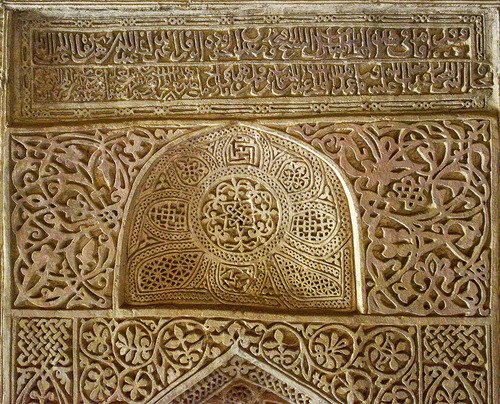
Mihrab of The Great Mosque of Bahla, Oman
The central arch and rosette with surrounding freehand panel of the mihrab of The Great Mosque of Bahla in the Sultanate of Oman.

Mihrab of The Great Mosque of Bahla, Oman
The central arch and rosette with surrounding freehand panel of the mihrab of The Great Mosque of Bahla in the Sultanate of Oman. This mihrab is the only one of the five surviving examples of the work of Abdullah bin Qasim bin Muhammad al-Humaimi in which he did not incorporate a porcelain dish in the centre of the rosette.
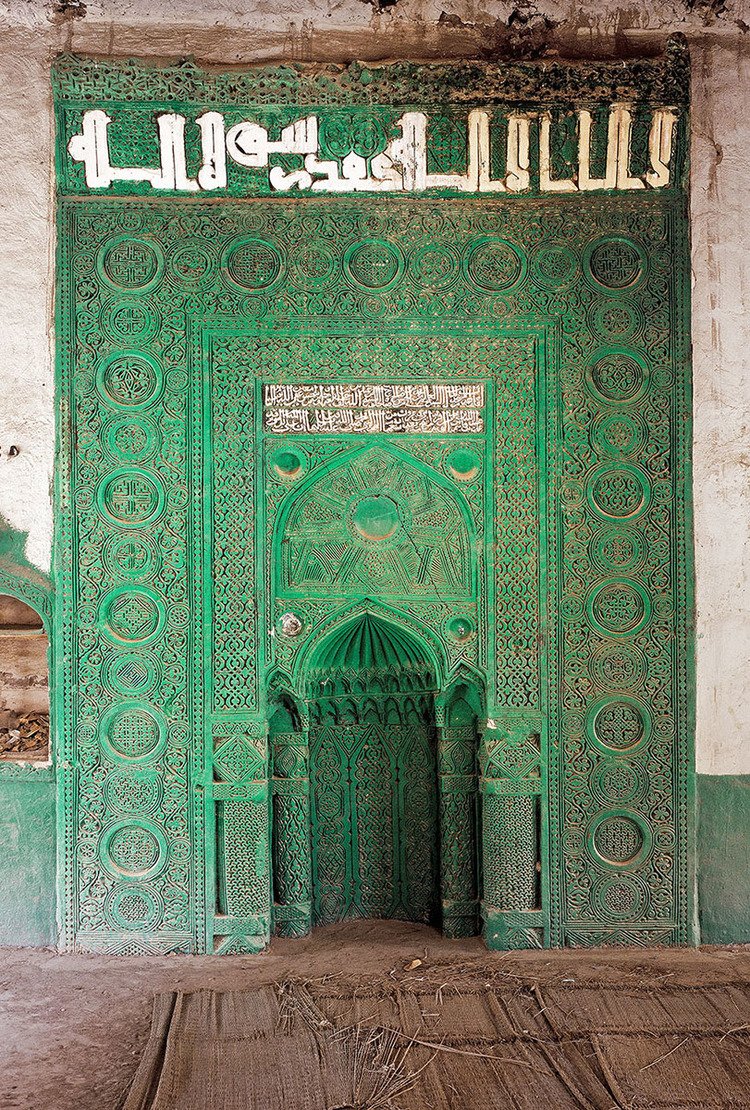
Al-Masjid ash-Sharah mihrab, Harat al Bilad, Oman
The carved stucco mihrab of Al-Masjid ash-Sharah is a late surviving example of the work of Abdallah bin Qasim bin Muhammad Al-Humaimi and dates from 922 AH/1516-7 CE. The mihrab would originally have been unpainted, the green gloss coat being a modern application. The large inscription in Kufic script along the top of the mihrab is the Shahada, (Confession of Faith), which is the First of the Five Pillars of Islam. It reads:
La ilaha illa Allah wa-Muhammad rasul Allah
There is no God but Allah and Muhammad is the Prophet of Allah
Typical of most of the remaining carved maharib in Oman, the name of Muhammad (Peace Be Upon Him) is in the centre of the inscription, directly above the prayer niche.
The two-line inscription reads:
This blessed mosque was erected by the savant Sheikh Muhammad bin Abu l-Hasan and by Salih bin Sabah and by Sheikh Halaf bin Abdallah bin Halaf bin Abu l-‘Abad and Halaf bin Belhasan bin Mu‘in may God forgive them in the Day of Judgment.
Work of Abdallah bin Qasim bin Muhammad al-Humaymi from the village of Manh in the year two and twenty after nine hundred [A.D. 1516-7] from the Hegira of the Prophet Muhammad, God bless him and grant him salvation. God is powerful over everything.
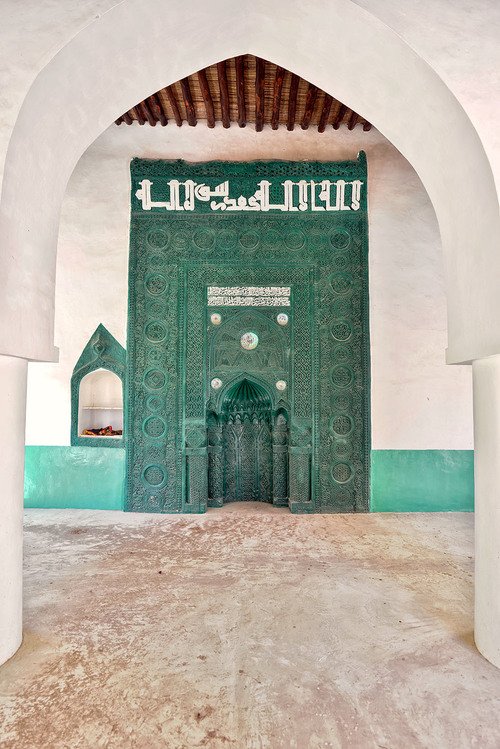
Al-Masjid ash-Sharah mihrab, Oman
The mihrab of Al-Masjid ash-Sharah in Harat al-Hilad, Sultanate of Oman, after restoration and cleaning.
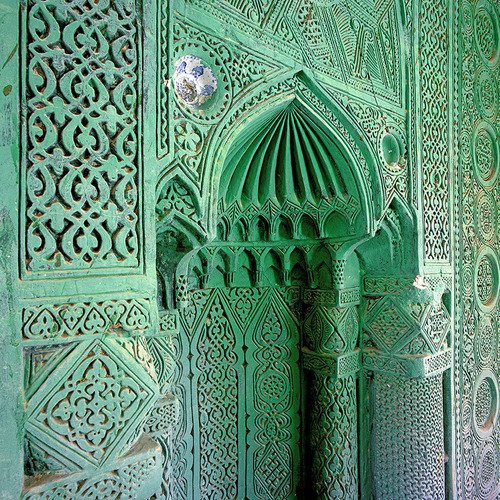
Al-Masjid ash-Sharah mihrab, Oman
Detail of the mihrab of al-Masjid ash-Sharah in the ancient fortified settlement of Harat al-Bilad, Sultanate of Oman. Note the ceramic bowl in each spandrel of the prayer niche arch.

Folk Ming dish, Al-Masjid ash-Sharah mihrab, Oman
The Folk Ming porcelain blue and white dish inset in the centre of the rosette of Al-Masjid ash-Sharah mihrab, Harat al-Bilad, Sultanate of Oman. The dish, which depicts a phoenix in flight amid lotus scrolls was revealed after paint overlay was removed during restoration in 2013.

Mihrab of the Great Mosque of Al-Gharid, Nakhal
This mihrab is the work of Mushmil bin Umar al-Manhi and is dated 923 AH, corresponding to 1517-18 CE. The mihrab originally incorporated at least 13 and possibly 15 ceramic plates and dishes, possibly Chinese in origin, as part of its decorative scheme. These have long since been removed.

Great Mosque of Al-Gharid Mihrab Detail
Detail of the carved stucco mihrab of the Great Mosque of Al-Gharid in the Wiliyat of Nakhal, Sultanate of Oman. The mihrab is the work of Mushmil bin Umar al-Manhi and is dated 923 AH, corresponding to 1517-18 CE.

Mihrab of Masjid al-Muqbara, Nakhal
The mihrab of Masjid al-Muqbara in Nakhal. This is a modern copy of the original, of which only the inscription is preserved. This gives the name of the craftsmen, Musmil bin Oman bin Muhammed al-Manhi and his son Talib, and the date of construction, 923 AH, corresponding to 1517 CE.

Great Mosque of Al-Gharid, Nakhal
Interior of the Great Mosque of Al-Gharid in Nakhl, Sultanate of Oman. The carved stucco mihrab is the work of Mushmil bin Umar al-Manhi and is dated 923 AH, corresponding to 1517-18 CE.
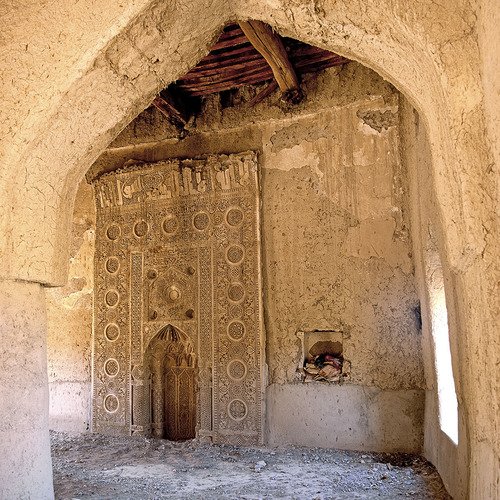
Al-Masjid ash-Sharja, Nizwa
The mihrab of Al-Masjid ash-Sharja, situated in the Sa'al quarter of Nizwa, Sultanate of Oman, is the work of Abdullah bin Qasim bin Muhammad al-Humaimi. It is the latest of the five surviving examples of his work and is dated 924 AH/1518-9 CE.

Al-Masjid ash-Sharja Mihrab, Nizwa
The mihrab of Al-Masjid ash-Sharja, situated in the Sa'al quarter of Nizwa, Sultanate of Oman, is the work of Abdullah bin Qasim bin Muhammad al-Humaimi. It is the latest of the five surviving examples of his work and is dated 924 AH/1518-9 CE.

Detail of mihrab of Al-Masjid al-Awayna, Wadi Bani Khalid
Central section of the mihrab of Al-Masjid al-Awayna in Wadi Bani Khalid, Sultanate of Oman, probably dating from the 1560s CE.

Al-Masjid ash-Sharja, Nizwa, Oman
Detail of the mihrab (prayer niche) of Al-Masjid ash-Sharja in Nizwa, Sultanate of Oman. The mihrab was carved by Abdullah bin Qasim bin Muhammad al-Humaimi in 1517 CE.

Al-Masjid ash-Sharja Mihrab detail
Roundel contained in an endless-knot and surrounded by floral decorations perhaps symbolic of the Gardens of Paradise.
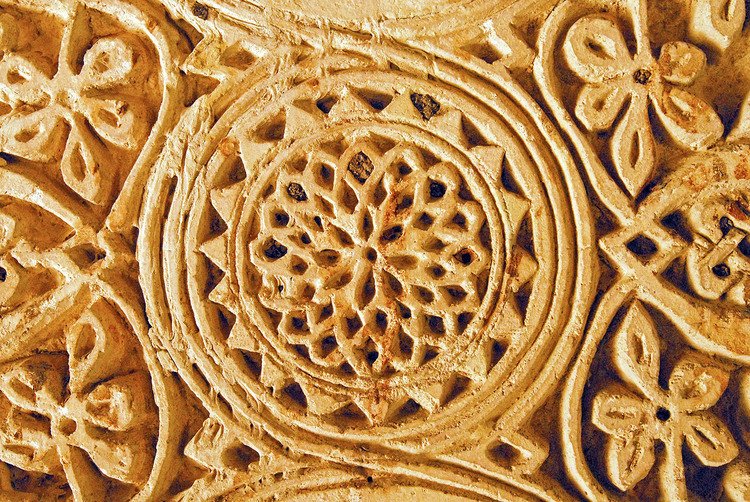
Al-Masjid ash-Sharja mihrab detail
A roundel and floral decorations in the outer band of the mihrab of Al-Masjid ash Sharja, Nizwa

Al-Masjid ash-Sharja mihrab detail
Roundels and floral patterns in the mihrab of Al-Masjid ash-Sharja, Nizwa.

Masjid Ash-Sharja mihrab detail
The carved stucco mihrab of Masjid Ash-Sharja, Nizwa, Sultanate of Oman, following restoration.

Masjid Ash-Sharja mihrab detail
Central section of the carved stucco mihrab of Masjid Ash-Sharja, Nizwa, Sultanate of Oman, following restoration. The mihrab is the work of Abdullah bin Qasim bin Muhammad al-Humaimi and is dates 924 AH, corresponding to 1518-19 CE.

Masjid al-Jinnah Mihrab, Nizwa
The mihrab of Masjid al-Jinnah in Nizwa. The name of the craftsman is not recorded, though the date of construction is given as 925 AH, corresponding to 1519 CE.

The Mihrab of Masjid al-Jinnah, Nizwa
The mihrab of Masjid al-Jinnah in Nizwa. The name of the craftsman is not recorded, though the date of construction is given as 925 AH, corresponding to 1519 CE.

The Mihrab of Masjid al-Jinnah, Nizwa
A porcelain dish inset in the mihrab of Masjid al-Jinnah in Nizwa. The name of the craftsman is not recorded, though the date of construction is given as 925 AH, corresponding to 1519 CE.

The Mihrab of Masjid al-Jinnah, Nizwa
A porcelain dish inset in the mihrab of Masjid al-Jinnah in Nizwa, dating from 925 AH, corresponding to 1519 CE.

The Mihrab of Masjid al-Jinnah, Nizwa
A roundel of the mihrab of Masjid al-Jinnah in Nizwa, dating from 925 AH, corresponding to 1519 CE.
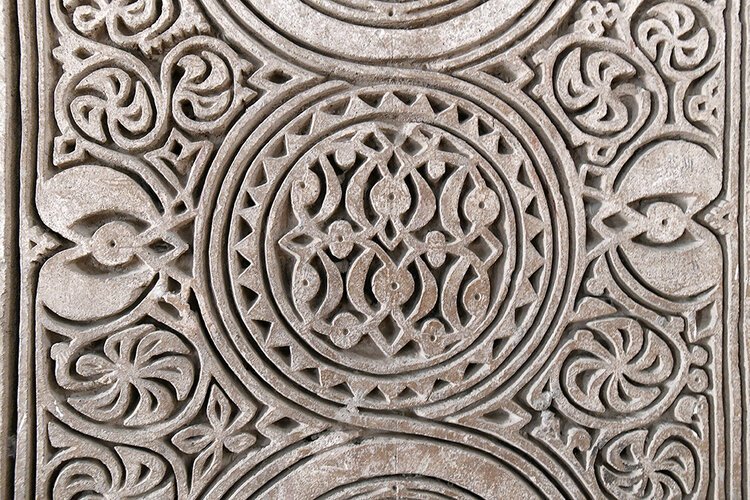
Masjid Al-Jinnah Mihrab Detail
A roundel of the carved stucco mihrab of Masjid Al-Jinnah in Nizwa, dating from 925 AH/1519 CE.

Masjid Ash-Shawadina Mihrab, Nizwa
The carved stucco mihrab of Masjid Ash-Shawadina in Al-Aqr quarter of Nizwa, Ad-Dakhiliyah Governorate. The mihrab is the work of Issa bin Abdullah bin Yusuf and is dated Ramadhan 936 AH, corresponding to April-May 1530 CE.
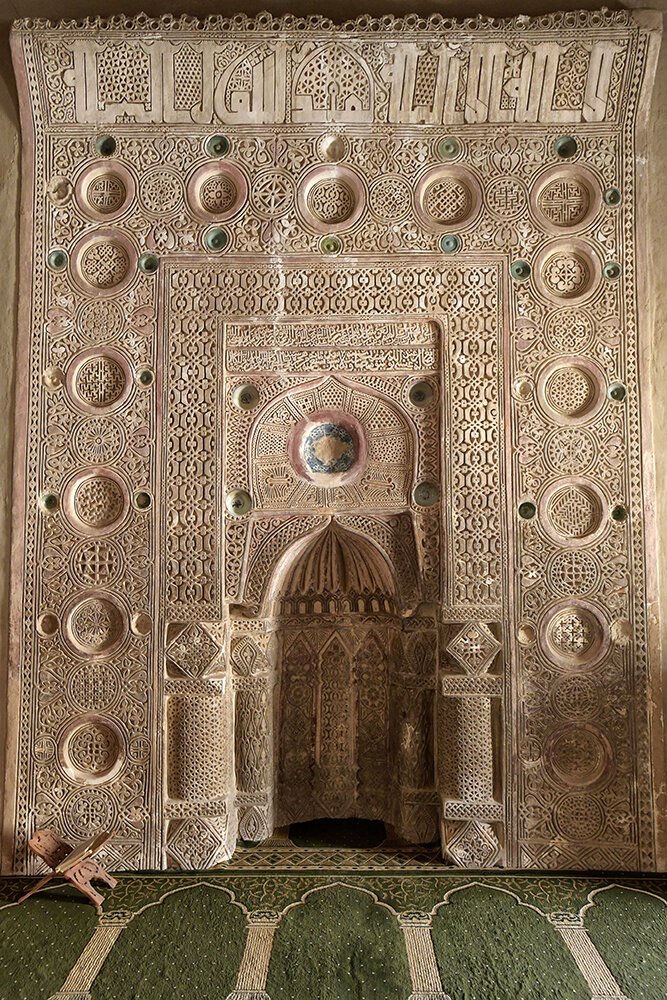
Masjid Ash-Shawadina Mihrab, Nizwa
The carved stucco mihrab of Masjid Ash-Shawadina in Al-Aqr quarter of Nizwa, Ad-Dakhiliyah Governorate. The mihrab is the work of Issa bin Abdullah bin Yusuf and is dated Ramadhan 936 AH, corresponding to April-May 1530 CE. The blue and white porcelain dish set in the centre of the rosette (now broken) depicted a qilin, a creature from Chinese mythology.
![Great Mosque of Manah mihrab
The carved stucco mihrab of the Great Mosque of Manah, made by “Issa bin Abdullah bin Masud Yusuf bin Saif from Bahla in the year one and forty of nine hundred [AH]”, corresponding to 1534-5.](https://images.squarespace-cdn.com/content/v1/61774ef8b97f2131e80a7010/8aba4fc3-8974-4e34-a4a1-09c68b5b6c0e/Harat-al-Bilad-1-jpg.jpg)
Great Mosque of Manah mihrab
The carved stucco mihrab of the Great Mosque of Manah, made by “Issa bin Abdullah bin Masud Yusuf bin Saif from Bahla in the year one and forty of nine hundred [AH]”, corresponding to 1534-5.
![Great Mosque of Manah mihrab
The carved stucco mihrab of the Great Mosque of Manah, made by “Issa bin Abdullah bin Masud Yusuf bin Saif from Bahla in the year one and forty of nine hundred [AH]”, corresponding to 1534-5 CE.](https://images.squarespace-cdn.com/content/v1/61774ef8b97f2131e80a7010/0f9ecea3-916b-43d4-8bc5-e29e3988c8a1/Harat-al-Bilad-GM-22-8-20c.jpg)
Great Mosque of Manah mihrab
The carved stucco mihrab of the Great Mosque of Manah, made by “Issa bin Abdullah bin Masud Yusuf bin Saif from Bahla in the year one and forty of nine hundred [AH]”, corresponding to 1534-5 CE.
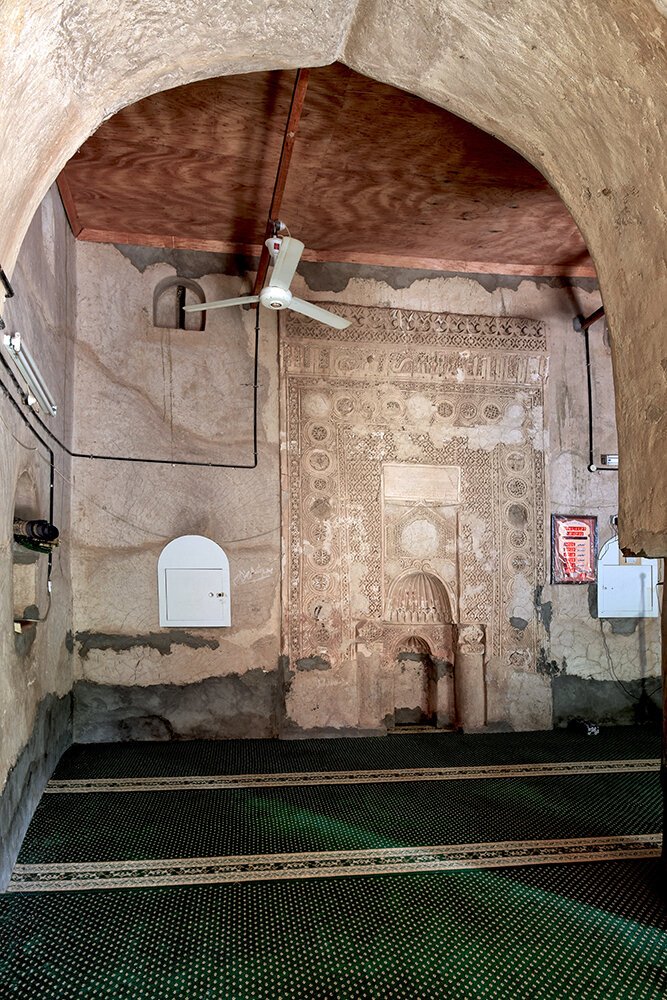
Masjid As-Sarooj, Sumail
The interior of Masjid As-Sarooj in Sumail, Sultanate of Oman. The mihrab is the work of Talib bin Mushmil al-Manhi. The date of construction as given in the inscription is unclear, but may be 979 AH, corresponding to 1562 CE.

Masjid As-Sarooj, Sumail
The mihrab of Masjid As-Sarooj in Sumail, Sultanate of Oman. The mihrab is the work of Talib bin Mushmil al-Manhi. The date of construction as given in the inscription is unclear, but may be 969 AH, corresponding to 1562 CE.

Al-Masjid al-'Awayna Mihrab, Wadi Bani Khalid, Oman
The carved stucco mihrab of Al-Masjid al-'Awayna in Wadi Bani Khalid, Sultanate of Oman. It was carved by Talib bin Musmil bin Umar, a native of Manah. The date in the inscription is no longer legible though we know that Talib bin Musmil was active during the 1560s CE. This mihrab is now in the National Museum in Muscat.

Al-Masjid al-'Awayna Mihrab, Wadi Bani Khalid, Oman
The central section of the carved stucco mihrab of Al-Masjid al-'Awayna in Wadi Bani Khalid, Sultanate of Oman. It was carved by Talib bin Musmil bin Umar, a native of Manah. The date in the inscription is no longer legible though we know that Talib bin Musmil was active during the 1560s CE. This mihrab is now in the National Museum in Muscat.

Detail of the Mihrab of Al-Masjid al-Awayna, Wadi Bani Khalid
The central section of the mihrab of Al-Masjid al-'Awayna in Wadi Bani Khalid in the Sultanate of Oman, which originally had three inset porcelain bowls. This mihrab is now in the National Museum in Muscat.

Detail of Al-Masjid al-Awayna Mihrab
Decorative pattern that forms part of the upper section of the mihrab containing the Shahada (Confession of Faith) in Al-Masjid al-Awayna in Wadi Bani Khalid in the Sultanate of Oman.

Al-Masjid al-Awayna, Wadi Bani Khalid
Roundel from the outer band of the mihrab of Al-Masjid al-Awayna in Wadi Bani Khalid, Sultanate of Oman.

Mihrab of Al-Masjid al-Awayna, Wadi Bani Khalid, Oman
Detail of the carved stucco mihrab of Al-Masjid al-Awayna in Wadi Bani Khalid, Sultanate of Oman.

Al-Masjid al-Awayna, Wadi Bani Khalid, Oman
Roundel and stylized floral pattern from the outer band of the mihrab of Al-Masjid al-Awayna in Wadi Bani Khalid, Sultanate of Oman.

Al-Masjid Al-Awayna, Wadi Bani Khalid, Oman
Roundel in the outer band of the mihrab of Al-Masjid Al-Awayna in Wadi Bani Khalid, Sultanate of Oman.

Al-Masjid al-Awayna, Wadi Bani Khalid, Oman
Fragment of a porcelain bowl of apparently Chinese provenance in the mihrab of Al-Masjid al-Awayna in Wadi Bani Khalid in the Sultanate of Oman.

Mihrab of Masjid Al-Awaina in the National Museum Muscat
Today the mihrab of Masjid Al-Awaina is on display in the National Museum, Muscat.
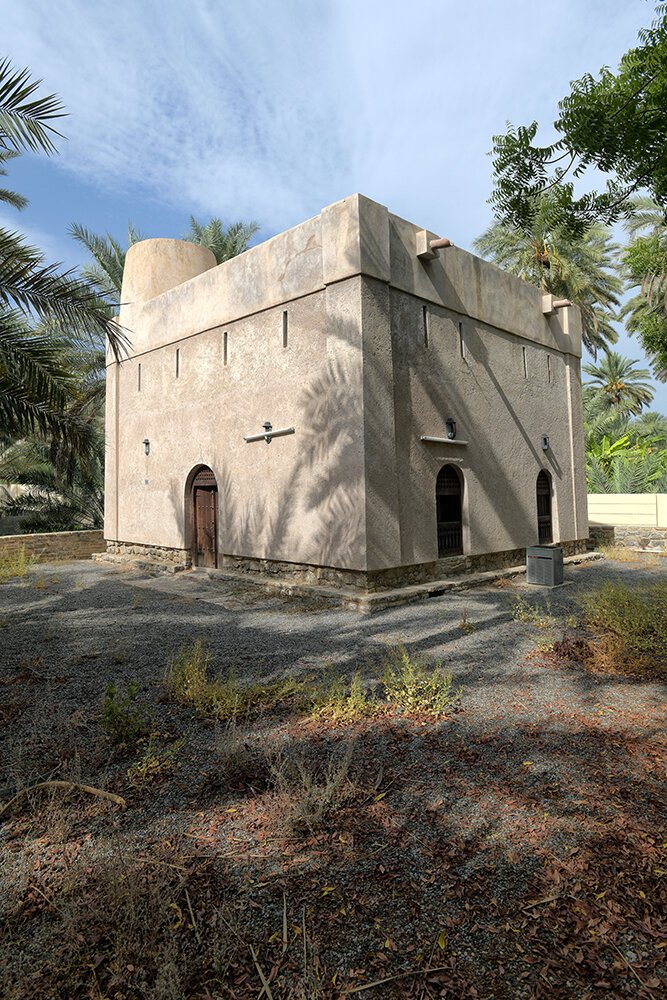
Masjid al-Muzara'a, Sumail
A traditional Ibadi mosque in Sumail, Sultanate of Oman, known as Masjid al-Muzara’a (The Garden Mosque). The mosque's mihrap is shown in the next image.

Mihrab of Masjid al-Muzara'a, Sumail
The carved stucco mihrab of Masjid al-Muzara’a, Sumail, is the work of Talib bin Mushmil al-Manhi and is dated 974 AH, corresponding to 1567 CE.

Interior of Masjid al-Muzara'a, Sumail
The carved stucco mihrab of Masjid al-Mazara’a, Sumail, is the work of Talib bin Mushmil al-Manhi and is dated 974 AH, corresponding to 1567 CE.

Interior of the Great Mosque of Muqazzah, Izki
The interior of the Great Mosque of Muqazzah in the Wiliyat of Izki, showing the carved stucco mihrab. The mihrab is the work of Ali bin Talib bin Mushmil al-Manhi and is dated 1029 AH, corresponding to 1619 CE.

Grand Mosque of Muqazzah Mihrab Detail
A Ming dish of the Wanli Period (1563-1620) set in the lower left outer band of the mihrab of the Grand Mosque of Muqazzah in the Wiliyat of Izki. The dish depicts three bulbuls in flight around a stylized peony blossom. The bulbul, with its crown of white feathers, is known in Chinese as ‘the white headed old man’ and so symbolizes ripe old age. The peony blossom is a symbol both of riches and honour and of spring. The combined motifs therefore symbolize wealth and honour throughout a long life.
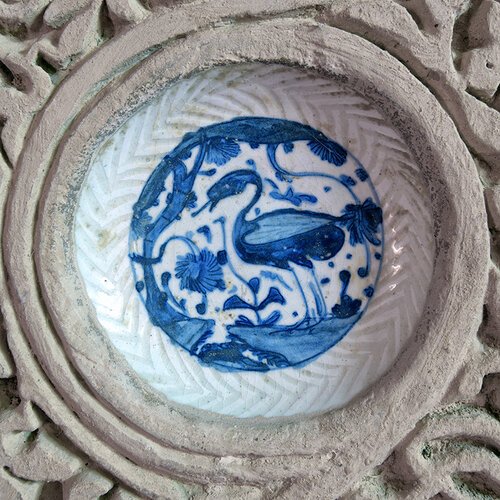
Great Mosque of Muqazzah Mihrab Detail
A Wanli Period (1572-1620 CE) Ming dish embedded in the lower left outer band of the mihrab of the Great Mosque of Muqazzah in the Wiliyat of Izki. The medallion depicts a crane, a Chinese symbol for longevity.

Great Mosque of Manal
The mihrab or prayer niche of Great Mosque of Manal, The inscription is lost but stylistic similarities with the mihrab of the Great Mosque of Muqazzah suggest it is the work Ali bin Talib Bin Musmil Al-Manhi and therefore dates from the early 17th century. The mihrab has been restored and the ceramic dishes are not the originals.

Masjid Al-Jebel mihrab, Nakhal
The mihrab or prayer niche of Masjid Al-Jebel in Nakhal, made by Majid bin Talib Bin Musmil Al-Manhi in the early 17th century. The mihrab has been restored and the ceramic dishes are not the originals.

Masjid Al-Jebel mihrab, Nakhal
The central section of the mihrab of Masjid Al-Jebel in Nakhal, Al-Batinah South Governorate, showing the inscription on either side of the arch. The inscription is today largely illegible.

Mihrab of the Great Mosque of Al Bu Rashid Quarter, Sinaw, Oman
The mihrab in the Great Mosque of the Al Bu Rashid Quarter of Sinaw in the Sultanate of Oman. It is the work of one Ali bin Talib bin Ali, a native of the town of Nakhl, and is dated 1068 AH/1658 CE.

Mihrab of the Great Mosque of the Al Bu Rashid Quarter, Sinaw, Oman
The mihrab in the Great Mosque of the Al Bu Rashid Quarter of Sinaw, Sultanate of Oman. It is the work of one Ali bin Talib bin Ali, a native of the town of Nakhl. It is dated 1068 AH/1658 CE.

Mihrab of the Great Mosque of the Al Bu Rashid Quarter, Sinaw
Central panel with porcelain dish and four satellite bowls, inscription and fluted prayer niche of the mihrab of the Great Mosque of the Al Bu Rashid Quarter of Sinaw, Sultanate of Oman.

Mihrab of the Great Mosque of the Al Bu Rashid Quarter of Sinaw, Oman
Inscription above the prayer niche of the mihrab of the Great Mosque of the Al Bu Rashid Quarter, Sinaw, Sultanate of Oman. The inscription reads:
This mihrab was completed Monday 22 Rabi
II of the year eight years and sixty years and thousand years [22 Rabi II of 1068 AH/27 January 1658 CE] by the hand of the master Ali bin
Talib bin Ali bin Kahal from Nakhal when Oman was under the rule of Imam Sultan bin Sayf
Erected by the sayh Sa
lih bin Ali
Al-Hashimi.
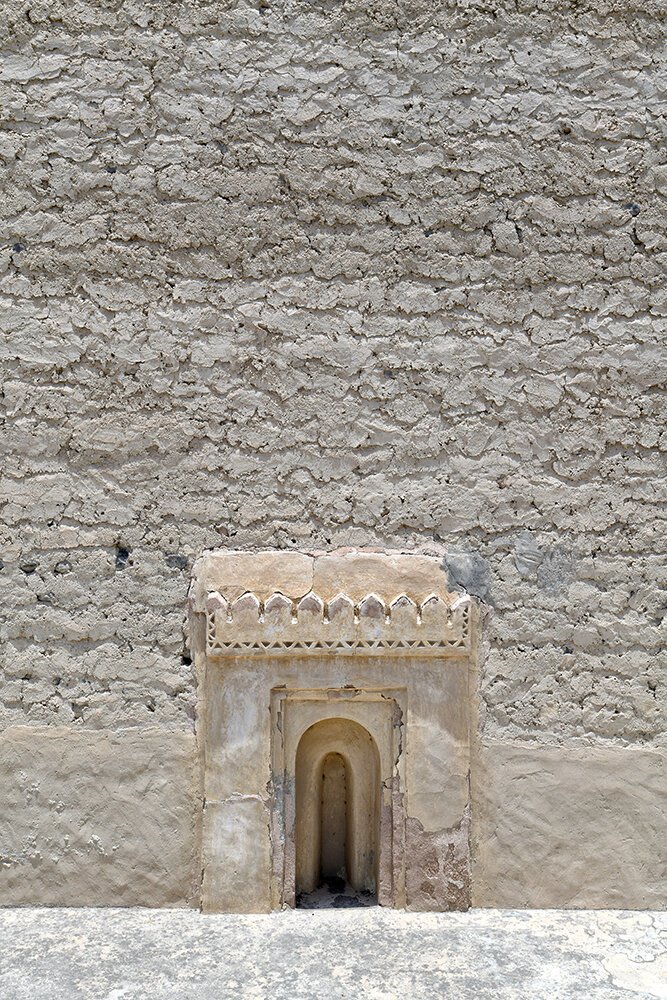
Great Mosque of Muslimat
The external mihrab or prayer niche of the Great Mosque of Muslimat, Al-Wadi Al-Ma’awil, Al-Batinah South Governorate.
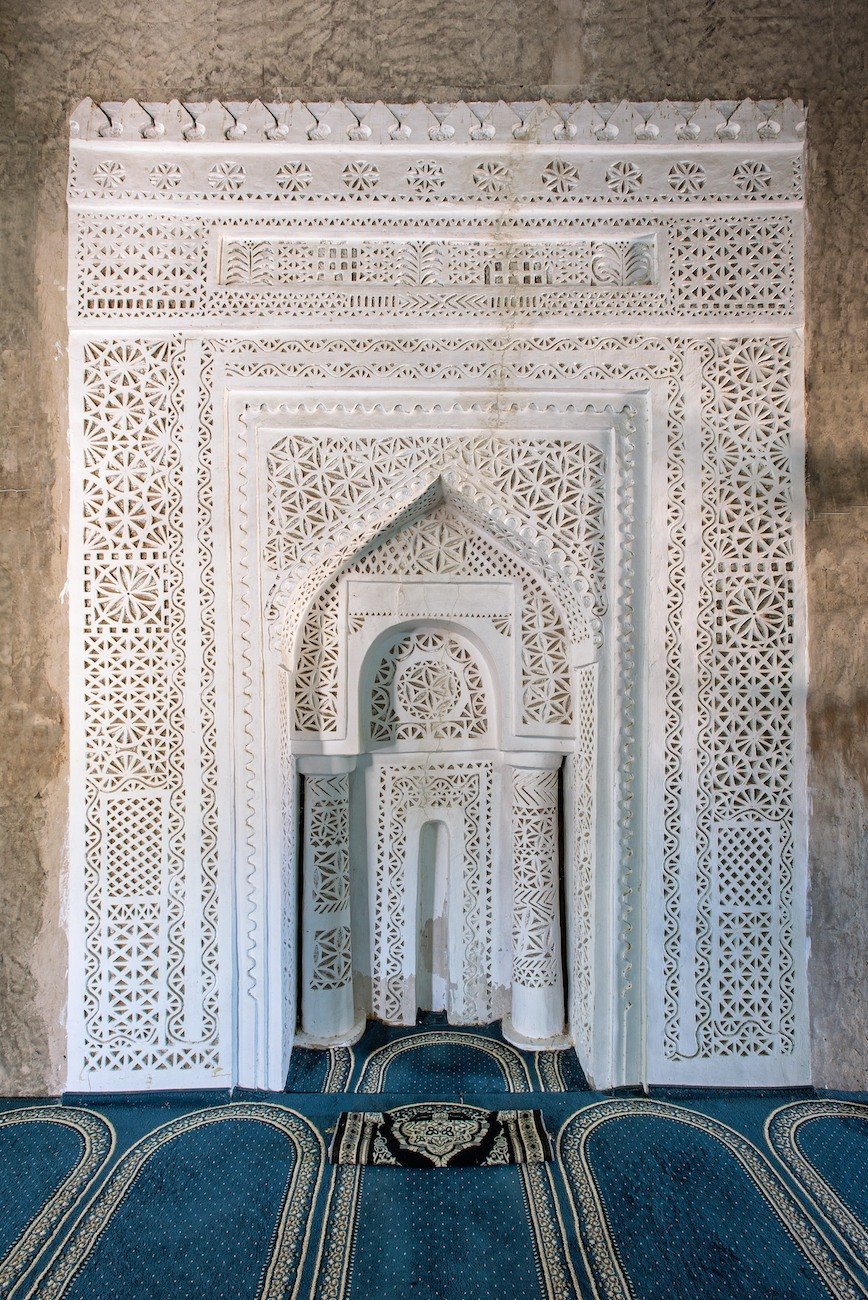
Great Mosque of Muslimat, Wadi Al-Mawil, Oman
Carved stucco mihrab in the Great Mosque of Muslimat in the Wiliyat of Al-Mawil, Sultanate of Oman. The mihrab is not inscribed and so nothing is known about its date of construction or who carved it.

Great Mosque of Muslimat, Wadi Al-Mawil, Oman
Carved stucco mihrab in the Great Mosque of Muslimat in the Wiliyat of Al-Mawil, Sultanate of Oman. The mihrab is not inscribed and so nothing is known about its date of construction or who carved it.

Masjid Al-Agbari Mihrab, Sumail
The carved stucco mihrab of Masjid Al-Agbari in Sumail, Ad-Dakhiliyah Governorate. The name of the craftsman is not recorded. The date of completion is given as 1245 AH, corresponding to 1829-30 CE.

Al-Hamra external prayer niche
External prayer niche of a mosque in Al-Hamra, Ad-Dakhiliyah Governorate.

Mihrab in a Mosque in Al-Kadra' in Oman
The mihrab of a ruined mosque in Al-Kadra Bani Daffa in the Sultanate of Oman.

Great Mosque of Harat Al-Shaybani Mihrab, Adam
The mihrab of the Great Mosque of Harat Al-Shaybani in Adam, Ad-Dakhiliyah Governorate.

Mihrab of Mosque in Al-Yemen Village, Izki, Oman
The mihrab (prayer niche) of the Friday Mosque in Al-Yemen village in the Wiliyat of Izki, Sultanate of Oman.
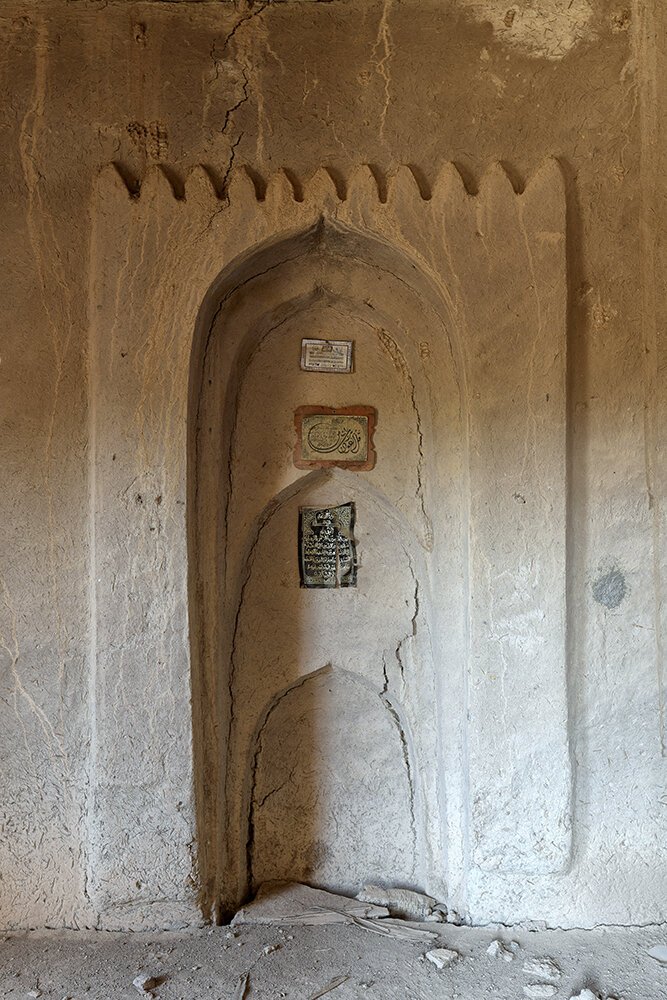
Manal Mosque Mihrab
The mihrab of a small mosque in Manal, Ad-Dakhiliyah Governorate, Sultanate of Oman.

Mihrab of Masjid Al-Mandhri, Nizwa
The mihrab of Masjid Al-Mandhri in Harat As-Suwaiq, Nizwa, Ad-Dakhiliyah Governorate, Sultanate of Oman.

Masjid Al-Ghadhanah Mihrab, Nizwa
The mihrab or prayer niche of Masjid Al-Ghadhanah in Harat Al-Suwaiq in Nizwa, Ad-Dakhiliyah Governorate, Sultanate of Oman.

Wadi Bani Habib Mihrab
The mihrab or prayer niche of a small mosque in Wadi Bani Habib, Al-Jebel Al-Akhdar, Ad-Dakhiliyah Governorate, Sultanate of Oman.
